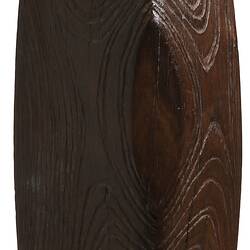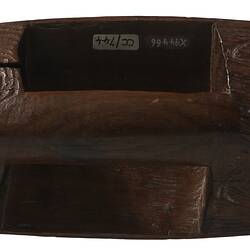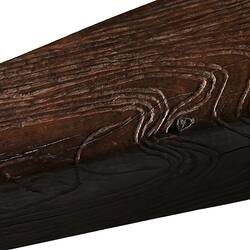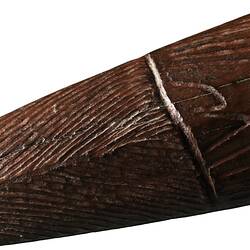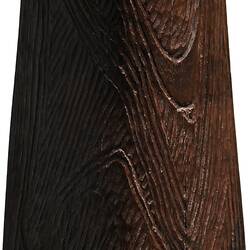Summary
Graceful bow-shaped mulga (parrying shields) with complex engraved designs were characteristic of the traditional artistic culture of New South Wales and Victoria Aboriginal men. The engravings needed to be done while the wood was still raw and green, as timber hardens over time and becomes difficult to work with.
This unusually shaped mulga has been made from a dense heavy wood, the intricate design etched with a sharp stone tool and then a mixture of animal fat and ochre has been rubbed into it to preserve the wood. Each craftsmen used similar design elements on their shields, but overall they were infinitely variable, and no two where exactly the same. However they all relate to individual and group identity and to the Country belonging to the master craftsmen who made them.
Local Name
Mulga
Physical Description
A wooden parrying shield carved into a elliptical shape with both ends cut square. Triangular shaped in a cross-section. Posterior shield has a handle cut deeply into it. Both surfaces are decorated with a singular line near each end. Posterior side has a curved line pattern all over it except for handle. The exterior side has curved concentric lines and carved shapes.
Significance
The man who carved this extraordinary mulga has created a vivid record of the features of the rivers, mountains, landscape and boundaries of his land. The same visual language was represented in the etchings on possum skin cloaks and carved into trees.
Unfortunately past collection practices were ignorant of the diversity and specificity of Aboriginal culture and the names of makers, their Country and Nation were not properly recorded. As a result we only know this mulga came from the broad area of Victoria and the linear designs featured are certainly a signifier that it was made in the southeast of Australia.
More Information
-
Object/Medium
Shield
-
Maker
-
Locality
-
Date Produced
-
Collector
-
Object Measurements
740 mm (Length), 110 mm (Width), 85 mm (Height)
-
Classification
-
Date Made
-
Maker
-
Clan/Language Group
-
Place Made
-
Indigenous Region
-
Keywords
-
Collection Names
-
Type of item
-
Discipline
-
Category
-
Collecting Areas

